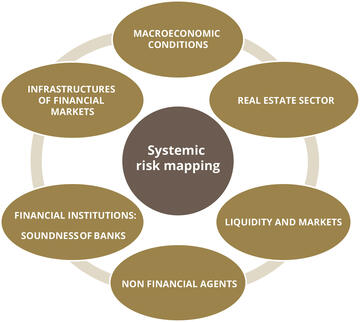Systemic risk mapping
Systemic risk mapping is a tool designed to identify and assess risks to the stability of the financial system. It is made up of 6 risk pillars, broken down into criteria and assessment indicators.
 |
The evaluation of indicators under the risk mapping is conducted by assigning a scoring from 1 to 5, reflecting the magnitude of risks, based on quantitative criteria (levels, trends, volatility and distribution of values) and qualitative criteria (expert judgment).
- Macroeconomic risk : this category includes risks induced by economic factors likely to affect financial institutions and financial markets.
- Real Estate sector risks : covers risks arising from trends in real estate market activity and the risk of a bubble forming.
- Liquidity and market risks : covers the risks of bank under-liquidity and pressure on bank collateral, as well as the risks of concentrated or shallow capital markets, and the risks of dispersion or excessive valuation.
- Non-financial agents risks : it covers risks linked to the financial situation of households and non-financial companies.
- Soundness of financial institutions (banks) risk : covers the risks that can impact banks' strength and resilience (risks linked to asset quality, profitability, solvency, market risks, ALM risks, etc.).
- Financial market infrastructure : assesses the resilience of systemic MFIs to credit, liquidity, operational, legal and systemic risks, and is based on the principles laid down by the BIS.
Search





























